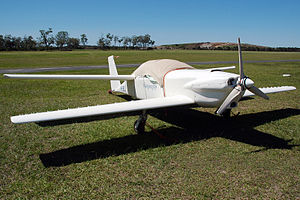
The Rutan Quickie is a lightweight single-seat taildragger aircraft of composite construction, configured with tandem wings.

The Murphy Maverick is a Canadian two-seat fixed-wing ultralight monoplane designed by Murphy Aircraft of British Columbia. The type is sold as a kit for home construction or as a complete ready-to-fly aircraft.

The Raj Hamsa X-Air is an Indian, two-seat, high-wing, tricycle gear, tractor configuration, ultralight aircraft produced by Raj Hamsa Ultralights of Bangalore, Karnataka in kit form, for amateur construction.

The Aero Synergie Jodel D20 is a French ultralight aircraft that was designed by Jean Délémontez and produced by Aero Synergie of Villefranche-de-Rouergue. The aircraft was supplied as a kit for amateur construction or as a completed aircraft.

The Aeropilot Legend 540 is a Czech ultralight aircraft, designed and produced by Aeropilot, introduced at the Aero show held in Friedrichshafen in 2011. The aircraft is supplied complete and ready-to-fly-aircraft.
The AV Leichtflugzeuge Vagabund is a German ultralight aircraft that was designed by Birk Meier, Hans Grannemann and Robert Kaps and produced by AV Leichtflugzeuge of Haren, Germany. The aircraft is supplied as a kit or plans for amateur construction or as a complete ready-to-fly-aircraft.

The Jodel D18 is a French ultralight aircraft, designed and produced by Jodel.
The Lucas L11 is a French ultralight aircraft that was designed by Emile Lucas. The aircraft is supplied in the form of plans for amateur construction.

The FMP Qualt 201 is a Czech ultralight and light-sport aircraft, designed and produced by FMP s.r.o. of Prague. The aircraft is supplied as a complete ready-to-fly-aircraft.
The Nexaer LS1 is an American light-sport aircraft, under development by Nexaer of Peyton, Colorado and first flown on 16 October 2006. The aircraft is intended to be supplied as a complete ready-to-fly-aircraft.
The Anglin J6 Karatoo is an Australian ultralight and light-sport aircraft that was designed by Jessie Anglin and introduced in 1982. Over the years the J6 Karatoo has been produced by several different manufacturers, including Amax Engineering of Donvale, Victoria, Skyway Aircraft and is currently built by Serenity Aviation of Australia. The aircraft is supplied as plans or as a kit for amateur construction.

The Protoplane Ultra is a French ultralight aircraft, designed and produced by Protoplane of Bagnères-de-Bigorre. The aircraft is supplied as a complete ready-to-fly aircraft.

The ULBI Wild Thing is a German ultralight aircraft, designed by R. Kurtz and produced by Ultraleicht Bau International (ULBI), of Hassfurt. The aircraft was supplied as a kit for amateur construction or as a complete ready-to-fly-aircraft.

The Distar UFM-13 Lambada is a Czech shoulder-wing, two-seat motor glider originally designed and produced by Urban Air and now built by Distar Air of Ústí nad Orlicí.
The Bagalini Colombo is an Italian homebuilt aircraft that was designed by Marino Bagalini. The aircraft is supplied in the form of plans for amateur construction.
The CEI Free Spirit Mk II, also called the Cabrinha Free Spirit Mark II and the Cabrinha Model 423, is a three-seat American homebuilt aircraft that was designed by Richard Cabrinha and produced by CEI of Auburn, California, introduced at AirVenture in 1995. The aircraft was intended to be supplied as a kit for amateur construction, but only prototypes seem to have been completed.

The Dickey E-Racer, also called the Sierra Delta E-Racer, is an American homebuilt aircraft that was designed by Shirl Dickey and produced by Shirl Dickey Enterprises of Phoenix, Arizona, first flown in 1984. When it was available the aircraft was supplied in the form of plans for amateur construction, with some parts available to facilitate faster construction.

The Aero Designs Pulsar is an American two-seat, low wing, ultralight and homebuilt aircraft that was designed by Mark Brown and first produced by Aero Designs of San Antonio, Texas, introduced in 1985. When it was available the Pulsar was supplied as a ready-to-fly aircraft and as a kitplane for amateur construction.
The Parrish Dart is an American canard-configuration homebuilt aircraft that was designed by Jimmy R. Parrish and produced by Parrish Aircraft Xperimental, Inc. of Plantation, Florida, introduced in 1995. When it was available the aircraft was supplied in the form of plans for amateur construction.

The TeST TST-5 Variant is a Czech homebuilt aircraft that was designed and produced by TeST Gliders of Brno, introduced c. 1998. When it was available the aircraft was supplied as a completely assembled aircraft, without engine or instruments, and also as a kit for amateur construction.















